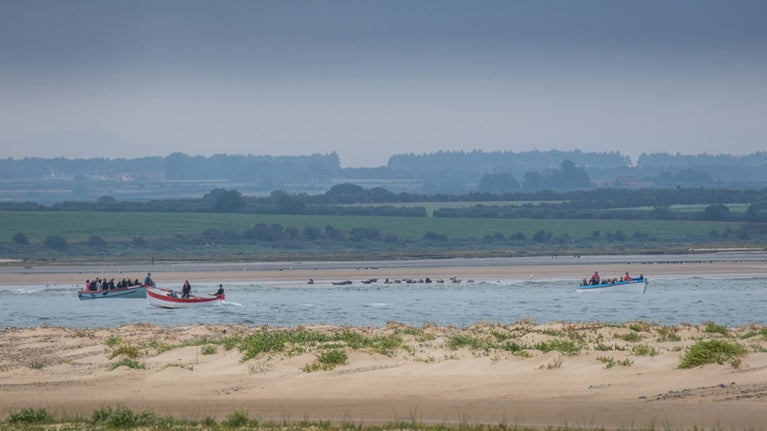
Where to go seal watching
Coastal walks are a great way to see seals, but you can also view them on a boat trip.

Around the UK you can spot grey seals and common seals. They both spend a lot of time at sea but they do come ashore to breed. Coastal walks are a great way to see seals, but you can also view then on a boat trip. Seals may seem common here, but they're more rare globally, so it's important to do all we can to keep them safe. Please follow these tips when watching out for them.
If you do spot them, please take care not to worry or disturb seals by following these seal-watching guidelines:
If a seal has a visible injury then please contact British Divers Marine Life Rescue (BDMLR) on 01825 765546.

In the wild, female grey seals can live 30–35 years whilst males live for about 20–25 years. Bulls reach sexual maturity at six years whilst cows are a bit earlier, at three to five years.
When they’re in the sea, seals spend 80 per cent of their time below water, and the rest on the surface breathing. They usually stay underwater for four to eight minutes at a time, although the maximum time recorded was 30 minutes. When diving, seals have been known to reach depths of up to 300m. They are commonly found diving at around 30m off British shores.
They moult their fur annually in the spring, after the breeding season and have a thick layer of blubber to keep them warm, which can be up 6cm thick. This blubber is built up during the warmer months and can be used for energy when required, such as during the breeding season.
Cows become fertile soon after weaning their pups. Bulls hold territories and those that are dominant may mate with over six cows. Protecting a harem is a full-time job, with males often not feeding for several weeks. Mating can take place on land or in water and sometimes sneaky non-dominant bulls will mate with a cow while the dominant bull is mating with another of his harem.
Pregnancy in grey seals lasts for 11½ months with the first 3½ months being delayed implantation. This delay gives cows time to feed up and moult after pupping.

Cows give birth to a single pup, weighing around 13.5kg – twins are very rare. Pups are born with a yellow coat, which turns white after a couple of days.
For the first three weeks, pups will feed up to six times a day. The milk contains around 60 per cent fat, helping pups grow very quickly, gaining about 2kg in weight each day. Pups are weaned at around three weeks of age, weighing between 45 to 50kg and it’s at this point they shed their white coat.
Every year, sadly, several grey seal pups don't survive the first three weeks of life, but this rate of mortality is typical of grey seal colonies. It's tough being a seal pup. Around 30 per cent of pups die within a month and half will die within their first year. Pups are weaned in 18 days, and they quadruple in weight in that time. After this they're abandoned by their mother and spend another 20 days or so in the colony before heading out to sea for an independent life.
Grey seals will mainly eat fish, squid and octopus, but have been known to also eat crabs. They locate food by sight and sound, but they also have incredibly sensitive whiskers which can help detect vibrations given off by fish swimming. Because of this, even blind seals can survive.
Grey seals are ‘capital breeders’. This means that both the females and males fast during their stay at their colony in the autumn. Over this period all their energy comes from their blubber. A female’s fast can be over 20 days long, while males can fast for over 50 days. This is thought to be one of the reasons seals have pups in the autumn. The longer a male can stay in the colony and defend his territory, the more successful they will be.
Commercial hunting for their skins began in the 18th century, however, by 1914 their numbers were dwindling. Grey seals were the first British mammal to gain protection and the Conservation of Seals Act (1970) gave them further protection, to allow numbers to recover.

Coastal walks are a great way to see seals, but you can also view them on a boat trip.
Get closer to nature by reading our guides on how to spot wildlife, facts about ancient trees and tips on identifying birdsong, plus many more activities.

Although otter numbers are on the rise, the shy and elusive marine mammals are still notoriously difficult to find. To boost your chances, here are our top tips on how to spot them in the wild.

Learn how to spot red squirrels, the best times to see them and how to tell them apart from grey squirrels.

Discover how we work to support a rich variety of land, nature and wildlife across England, Wales and Northern Ireland.
